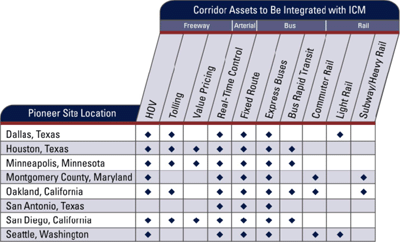ICM Pioneer Sites
The USDOT has selected eight "Pioneer Sites" to act as critical partners in the development, deployment and evaluation of Integrated Corridor Management (ICM) strategies designed to help manage congestion in some of our nation's busiest urban corridors as part of its 5-year ICM Initiative. The ICM Pioneer Sites are:
Visit each of these Pioneer Site pages to learn more about each site and view their ICM Concepts of Operations and System Requirements Specifications (not yet available for all sites).
 All eight Pioneer Sites are recognized leaders in the area of congestion management, and their efforts under this initiative will directly contribute to more efficient, faster moving, and safer corridors for the future. The corridors of each Pioneer Site include configurations and characteristics that the USDOT believes represent many other corridors across the nation and all possess infrastructure assets that can enable ICM. For example, all have implemented real-time signal control on their arterials. Many have implemented high-occupancy vehicle (HOV) and value-pricing strategies, while others have advanced bus operations that include express bus and bus rapid transit services. The table on page 12 provides a snapshot of the eight USDOT ICM Pioneer Sites and the existing infrastructure assets they will seek to integrate through ICM.
The Pioneer Sites will develop multimodal ICM strategies that apply new institutional and operational approaches and advanced technologies to existing infrastructure to help to increase travel time reliability, manage congestion and empower travelers. The USDOT's partnership with the Pioneer Sites will occur in three stages:
Stage 1—Concept Development (FY07). All eight sites will develop site-specific concept of operations (CONOPS) and requirements documents. Each site will also provide sample data for evaluation.
Stage 2—Modeling (FY08–FY09). Three sites will analyze and model their proposed ICM systems using USDOT-provided resources, methodologies and tools.
Stage 3—Demonstration and Evaluation (FY09–FY11). USDOT will select up to three sites to demonstrate ICM concepts that may have applicability to a broad range of corridors around the country.
The Pioneer Sites have completed development of their CONOPS and requirements documents. These documents are available by going to the individual site pages linked from the top of this page and from the ICM Knowledgebase Web site at www.its.dot.gov/icms/knowledgebase.htm.
Three pioneer sites have been chosen for stage 2 of the partnership from the eight pioneer sites shown above. Dallas, TX, Minneapolis MN, and San Diego, CA are modeling their proposed ICM systems. Preliminary results from this modeling and analysis are expected in late 2009.
Visit the ICM Web site regularly at http://www.its.dot.gov/icms/ for more information on the Pioneer Sites and updates on their progress in the development of innovative ICM strategies to manage congestion.
|

